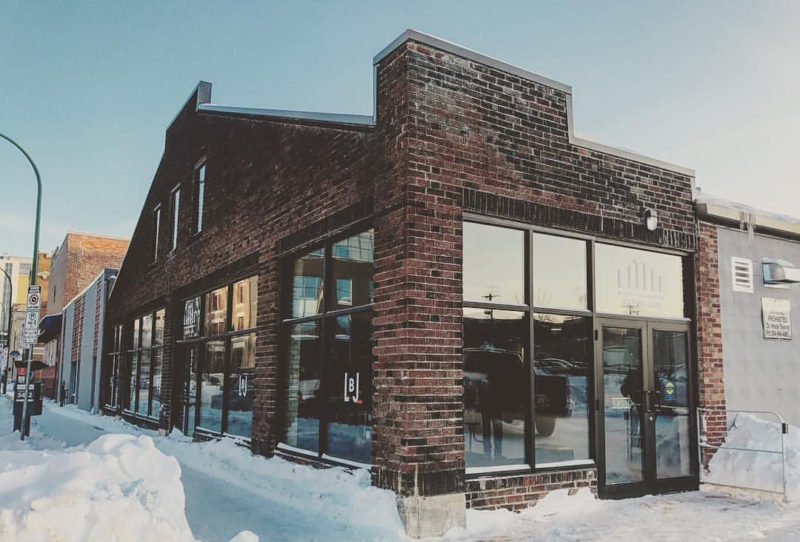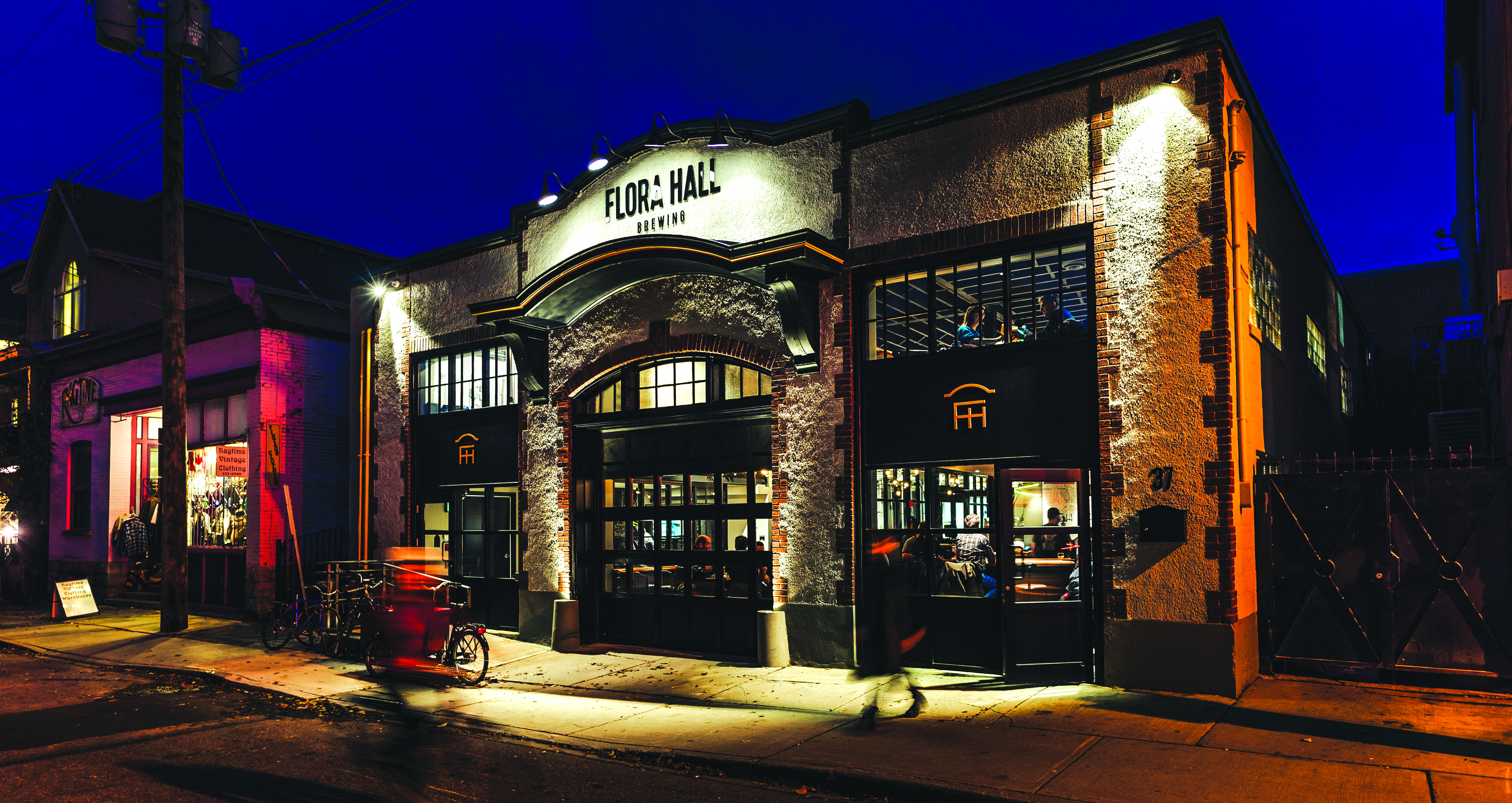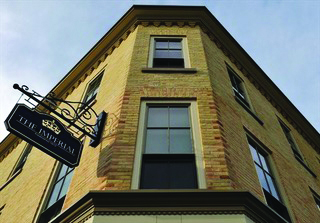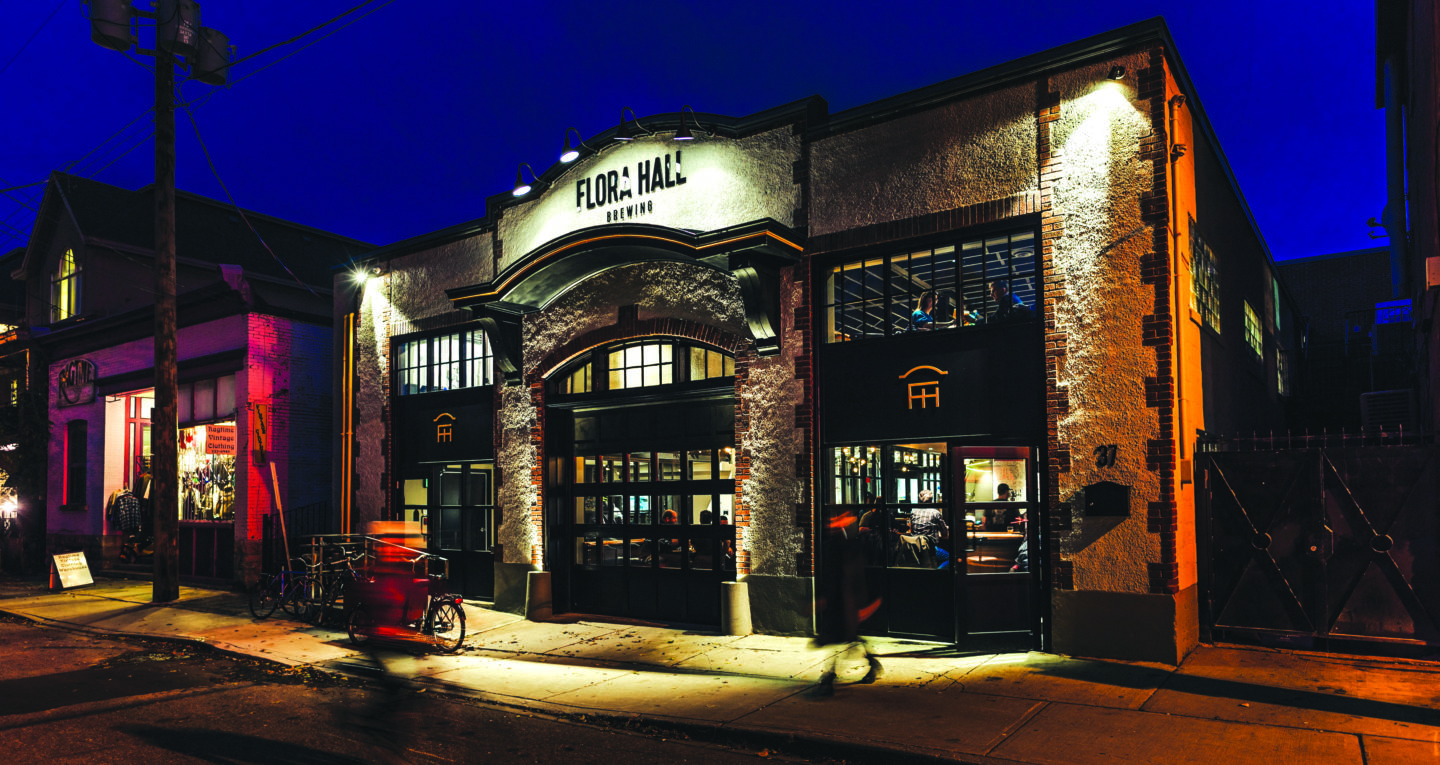Brewed in Heritage
Craft breweries are popping up across Canada at a record pace. Many are located in historic buildings and have become social hubs in their communities.
These breweries strive to create an authentic product and experience for their customers. This craft brewery culture is created in part to differentiate itself from the large multinational breweries that dominate the industry, but it is often also driven by a community-building desire on the part of the owners. As a result, it’s not uncommon to find a brewery repurposing a historic space.
Beer and heritage buildings are a fantastic pairing: brewers and heritage advocates both recognize the importance of the past and play an important role in the present and future of their communities. The care needed to select the right trades and materials for the repair of a historic building can be compared to the careful selection of local ingredients for use in craft brewing. Both undertakings are characterized by individuality and craftsmanship, in contrast with modern mass-production.
The 1882 Petrie Building in Guelph, ON – the last remaining machine-stamped metal clad building in Canada – is a case in point. Named to the National Trust’s Top 10 Endangered Places List in 2014, today the building boasts a newly repaired sheet metal façade, and a ground floor brewpub, Brothers Brewing Company.
When the restoration of old buildings and the resurgence of the local brewery come together, the results can be intoxicating – in the best sense of the word. Much like the process of brewing craft beer, the examples on these pages show attention to detail, respect for tradition, and the balance between old and new.
Silversmith Brewing Company (Niagara-on-the-Lake, ON)
Former use: Anglican Church, antique store

Silversmith Brewing Company set up shop in a former Anglican Church.
This brewery established in a 120-year-old church is located in a region renowned for vineyards and winery tours. German-style beers now draw in a strong congregation of locals and visitors to enjoy the space, food, beer, and social atmosphere.
When asked why they chose to locate in a heritage building, Silversmith Brewing Company President and CEO Chris Pontsioen explains it was no coincidence. “Locating in a historic building brings authentic character, uniqueness, and distinction to everything we do,” says Pontsioen. “It provides our customers and staff with the intangible sense that they’re participating in another captivating chapter of an ongoing story. It demonstrates our commitment to heritage and affords people the opportunity to participate in heritage repurposed for the future.”
The church has been well preserved and carefully altered to suit its current purpose. The large windows and stained glass let in abundant light and the open space is great for gathering. While some see irony in a place of worship becoming a brewery, others have noted the rich history between religious orders and brewing beer, such as the Trappist beers brewed by monks in Belgian monasteries.
Silversmith’s respect for the space can be seen in their efforts in preservation of the church and especially in the design of the eventual addition that was needed to help the brewery grow to keep pace with demand.
“The real challenge of adaptive reuse in our case was ensuring the structural and aesthetic integrity of the church while ensuring the addition was functional as a brewery,” says Pontsioen. “The foundation of the church is made of fieldstone which has withstood the test of time beautifully and it required extensive design consideration not to disturb it.” To best protect the integrity of the church, the addition, which houses the industrial tanks and equipment necessary to brew beer, was built to be removable and structurally independent.
“The real showstopper of the addition is the glass front wall that exposes our brew house. There’s lots of ‘industrial’ intricacy and detail that both contrasts and complements the historical intricacies and details of the church.”
Port Rexton Brewing (Port Rexton, NL)
Former use: schoolhouse, community centre

Owners of Port Rexton Brewing, Alicia McDonald and Sonja Mills.
On the east coast of Canada, Port Rexton Brewing is another great example of a brewery located in a heritage building. The newly established brewery, guided by owners Sonja Mills and Alicia McDonald and located about three hours from St. John’s, NL, strives to be a community focal point. Fittingly, they have set up in the town’s former school that was built in the 1840s and later converted into a community centre. Now the building has “graduated” to become a brewery.
“Our place has become a real community social hub for the area and we’ve had so many people there who have stories of the building from both when it was a community centre and even back when it was a school,” says Mills. Locals will often reminisce about the old school and tell its stories, an activity well-paired with enjoying fresh beer. During renovations, a cache of notes, tests, and graded papers was discovered. Locals confirmed this was an old stairwell where students left notes for each other. The old memories were boxed up and donated to the Port Rexton and Area Heritage Society.
One of the brewery’s best beers gives a nod to the building’s educational past: T-Rex Porter is named for Thomas Rex, the school’s last principal and a respected community member. His legacy continues as a rich dark porter.
Port Rexton’s owners encountered challenges when renovating the old building including decayed boards and poor insulation. “Storage is an issue and efficiencies aren’t the greatest,” says Mills. “However, we are working the best we can with the space we have and would never trade it in a million years – the history, physical beauty, and stories were all worth it.”
Little Brown Jug Brewing Company (Winnipeg, MB)
Former use: livery stable, motor coach garage

Little Brown Jug in Winnipeg, MB.
Little Brown Jug Brewing Company Founder Kevin Selch returned to Winnipeg a few years ago with a vision: “To build the city we want to live in.” And his vision of the city clearly included a brewery.
The building he chose to house Little Brown Jug is located in the downtown Exchange District. The demise of rail, the 1919 general strike, and the crashes of the 1980s and 1990s left the city in a tough spot economically. Today, with the city rebounding, one benefit of these downturns is that there are untouched old industrial neighbourhoods like the Exchange that are now brimming with potential.
The former livery stable for City Hall had been transformed into a motor coach garage in the 1920s before quietly awaiting its new purpose as a brewery. The A-frame one-and-a-half storey building with a long glass front-façade is striking. The brewery has taken advantage of the open concept to showcase their industrial wares and brighten the space with lights: a beacon of warmth for those walking by on cold Winnipeg winter nights.
The approach taken during the construction of the brewery was to keep all the historic features that could be salvaged and update those that couldn’t with modern additions. Selch notes that the contemporary additions are meant to juxtapose the heritage features: “Everything old will be old; everything new will be new.” Some of the “new” is cutting edge. The building is heated and cooled using the off-heat from the brewing process. This steam energy heat exchange ensures that nothing is wasted or vented outside. The waste water is also treated on site to limit its impact on the municipal infrastructure.
The hope of the owners is that the brewery will be a catalyst for the neighbourhood as it continues to evolve. New shops, restaurants, and businesses are setting up in the area. The brewery, already a popular watering-hole for locals, has hosted concerts, pop-up farmers’ markets, and events.
Their mainstay beer, 1919 Belgian Pale Ale, pays homage to an important year for Manitoba. 1919 was the year of the General Strike in Winnipeg, which saw almost 30,000 labourers walk off the job. This was also the year that the hop varietal Brewers Gold was bred. Though bred in England, it was created from a wild strain of hops grown at a research station in Morden, MB.
Flora Hall Brewing (Ottawa, ON)
Former use: garage, warehouse, engineering building

Flora Hall Brewing, on Flora Street in Ottawa, ON. Photo by Ben Welland.
Ottawa, ON’s Flora Hall is a labour of love. Owner Dave Longbottom, through a long career of business travel, earned a wealth of experience in pubs and watering holes across the globe. Learning what design features create an atmosphere for social imbibing, he applied his knowledge to repurposing a former garage and engineering building in downtown Ottawa into a brewery and beer hall.
Location was important for the brewery, but an authentic space was even more important. “For me, there is no replacement for history and roots,” says Longbottom. “The vision for Flora Hall was to establish a permanent neighbourhood gathering spot for Centretown and greater Ottawa residents alike – a permanent neighbourhood brewery and kitchen that harkens back to the time when everything was sourced and enjoyed locally.” The success of the new business was immediate, as evidenced by the lineup of beer fans who eagerly waited for the doors to open on the first day.
The building had sat vacant for years in a neighbourhood that was quickly changing. Through its 100-year life, it had an impressive resumé, existing as an engineering office and warehouse before becoming a motorcycle parts and repair shop, and later an automotive repair garage. This industrial heritage is obvious from both the exterior and interior and was purposefully designed, says Longbottom. “We were very careful to embrace the warehouse/ industrial past by replacing old concrete floors with new, adding structural steel staircases and railings, reconstructing warehouse style windows, and retaining the exposed roof structures and other elements wherever possible.”
No design feature escaped consideration. Seats are offered at varying heights, taps are located on the wall so as to not interfere with sightlines, standing rails and high bars offer a place to lean and bend an elbow, while the central horseshoeshaped bar invites conversation between those saddled up enjoying a pint.
Working with an older space had its challenges. “There is no question that repurposing an old heritage structure is not for the faint of heart!” says Longbottom. “All in all, yes the costs were higher, and yes there were a few surprises and engineering challenges along the way, but I would do it all again in a heartbeat.”
Junction Craft Brewing (Toronto, ON)
Former use: incinerator, waste transfer facility
Junction Craft Brewing takes adaptive use to new heights: the former contract brewery now occupies a large art deco building that was once a waste transfer station and incinerator. Yes, an incinerator.
The Toronto, ON heritage building, known as the Destructor on Symes, had been vacant for years before efforts were made to clean up the space for events, a tap room, and the brewery.
The 1930s building has inspired the brewery, according to President and Founder Tom Paterson. “You can tell it has great bones,” he says. “Built to last. Massive beams. Huge slabs of concrete. Beautiful brickwork. Solid foundation that kind of mimics what we aspire to be as a business and as a brewery. Someone you can trust. Reliability and consistency is what you want from a brewery.”
Interestingly, the Junction community was still under Prohibition up until the 1990s. Prohibition was the 1920s criminalization of the manufacturing and consuming of alcohol.
Most Canadian jurisdictions repealed these laws in the early 1930s. Yet, more than a half-century later, Junction was still technically a dry neighbourhood. The irony that it now boasts a brewery is almost as delicious as the beer it produces.
Paterson focuses on the support the project has received: “The historical board has been amazingly supportive. So many old buildings get torn down and not repurposed like this one. It was designed to be a garbage incinerator, not a brewery. We had to be creative in setting up our systems.”
Bitte Schön Brauhaus (New Hamburg, ON)
Former use: hotel

Bitte Schön Brauhaus in New Hamburg, ON.
The small village of New Hamburg, in the Region of Waterloo, ON is a rural community with strong Germanic ties. Local resident and historian Marie Voisin purchased the Imperial Hotel in the town centre and began restoring the building with painstaking care. She approached Robin Molloy and Lee Brooks, owners of Descendants Brewing in Kitchener to establish a brewery in the hotel. They opened Bitte Schön Brauhaus.
“Locating in a building steeped in the German heritage of Wilmot Township provides an authenticity to our choice of brews,” says Molloy. “I received my Brewmaster designation in Berlin at the Versuchs- und Lehranstalt fuer Brauerei in 2012. We predominantly brew German style beers but we’re open for anything interesting.”
In addition to connecting to Germanic roots (they even have an umlaut in their name), the brewery aims to pay respect to the local history. “It was really important to us to keep the heritage of the building whenever we could,” explains Brooks. “We made an extra effort to reclaim brick from the original building and use it as an interior façade. We also have photos in our tiny space of the original Rau Brewery that existed in New Hamburg long ago. We definitely wanted to pay homage to those who came before us.”
The historic building also offers rental residential units and traditional first floor commercial amenities including a bakery, restaurants, and the brewery.
The craft brewing industry was founded as a rejection of the large-scale production of beer by a few multinational corporations. Consumers are drawn to craft beer because it is local, more flavourful, offers character, and tells a better story. These same elements are found in the buildings that are home to these breweries – with character, authenticity, and history “brewed in.”


